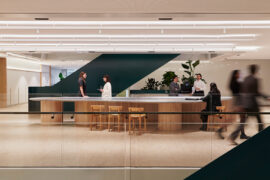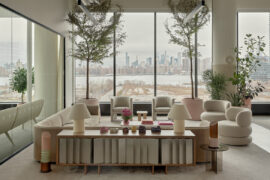Following a recent visit by Nendo’s Oki Sato, Simone LeAmon looks at Nendo’s relationship with lighting manufacturer Oluce and finds some lessons for Aussie designers trying to bridge the gap between Australia and Milan.
Following a recent visit by Nendo’s Oki Sato, Simone LeAmon looks at Nendo’s relationship with lighting manufacturer Oluce and finds some lessons for Aussie designers trying to bridge the gap between Australia and Milan.
March 28th, 2011
The dream of being a signature designer with secure relationships with Europe’s leading high-design manufacturers is common and blighted – for many talented designers – only by that classically Australian geographical cliché ‘the tyranny of distance’. What can make the journey even more difficult is that arriving in Milan only confirms what we feel at home; the reality of being bit players in a grand production that places star power centre stage.
Since 2003 I have been slowly developing a relationship with a few of the world’s leading high-design manufacturers. This article focuses on what I have gleaned from working with lighting manufacturer Oluce since my first meeting with Antonio Verderi, president of Oluce in late 2003.
Oluce is an iconic name in 20th century lighting design. From the 1950s to the present day the company has worked with some of the most celebrated names in product design: Joe Colombo and Vico Magistretti are the two talents on which the company’s global reputation was built.
Inspired by the creative direction of Vico Magistretti, Antonio’s father Angelo grew Oluce – founded by Guiseppi Ostuni in 1945 – from an artisan-based workshop to a high-design lighting company (during these initial decades Antonio worked in the factory assembling lamps over the school holidays for pocket money).
Now at the reins, Antonio has developed a reputation for spotting design talent and Oki Sato from Nendo design studio in Tokyo is the most recent inclusion to the Oluce catalogue.
But the relationship between manufacturer and designer is not as intimate as it was in the post war period. Recently the star designers, like they are out of Hollywood, are taking control of the mode of production to ensure they earn a bigger piece of the profit pie than the small royalty. This has worked to strengthen and increase the amount of media space devoted to the designer, rather than the manufacturer in collaboration with a designer. The design market – the creative & manufacturing process – is more deregulated now, but strangely the consequence has been a greater reliance on name designers.
The development of designers underwriting the cost of some product development has benefited the major manufacturers who leverage off the extra marketing material being generated. Because of the web, even those designers who are not manufacturing but doing interesting prototypes and limited edition pieces, or event design for brands, get far more exposure.
Trend spotting now is about scouring the web, curated exhibitions and design publications and seeing who is about to reach the tipping point, and getting a contract signed with such designers just before this occurs.
Obviously, this trend has made it even more difficult for a talented unknown to get traction with the major manufacturers.
Breaking a new talent takes years and the path journeyed taken to arrive at a manufacturable product may be strewn with the detritus of many failed prototypes. This is increasingly a risk that medium-sized high-design manufacturers are looking to avoid.
Antonio met Oki Sato 5 years ago in 2003 at the Salon Satellite at the Milan fair. Now one of the hottest names in contemporary high-design Nendo’s ship has come in – the studio is growing in size and enjoying the patronage of manufacturers from across the globe.
Oki and his team have worked hard – but the chance meeting with Antonio put things in motion. In July this year the designer, manufacturer, local distributor and retailer in Euroluce came together in Melbourne for State of Design. Brought to Melbourne by Oluce and Euroluce, Oki Sato spoke at the Design Capital business seminar. In the capacity of Oluce Design Ambassador it was my job to liaise between the media and Nendo. If I was dealing with Marcel Wanders it probably would have been easier to satisfy the media’s thirst for non-design related, more lifestyle oriented interviews. Nendo draw a very thick line between professional and private information. They are very much in the ‘business’ of design and do not see the celebrity aspect of their work as critical or necessary.
This made me re-think the entire purpose of importing these designers to our shores.
Australian design festivals are about two key outcomes; 1) driving interest in Australian design and 2) giving new knowledge to the local sector by providing access to world leaders in various design disciplines. What most of the mainstream media failed to pick up on was the story of how a Japanese design firm has launched itself globally by collaborating with that country’s leading car manufacturers (in Lexus) and fashion designers (Issy Miyake). A small snapshot that already exhibits a far wider interdisciplinary approach than is possible locally.
If the mainstream media in Australia does not catch onto this story then there is little hope of the mainstream manufacturing community understanding the value of linking with local designers. The consequence will be that most of us will continue to cast our dreams right across that tyranny of distance and a local sensibility will still be focused around the hand-made limited edition design practice.
INDESIGN is on instagram
Follow @indesignlive
A searchable and comprehensive guide for specifying leading products and their suppliers
Keep up to date with the latest and greatest from our industry BFF's!

A curated exhibition in Frederiksstaden captures the spirit of Australian design

A longstanding partnership turns a historic city into a hub for emerging talent

Law is one of the oldest professions in the world but Architectus’ new design for Ashurst Sydney’s workplace at 39 Martin Place reflects and responds to contemporary shifts.

Leaning into local ingenuity is the key to finding architectural solutions to global problems, if these 5 impactful architecture projects of late are anything to go by.
The internet never sleeps! Here's the stuff you might have missed

Community, Country and climate were centred at the 2025 Australian Institute of Landscape Architects (AILA) Awards in Lutruwita/Tasmania on 21st October.

The New York headquarters of haircare brand, Amika, has been designed by Civilian as the antithesis of a standard business hub.